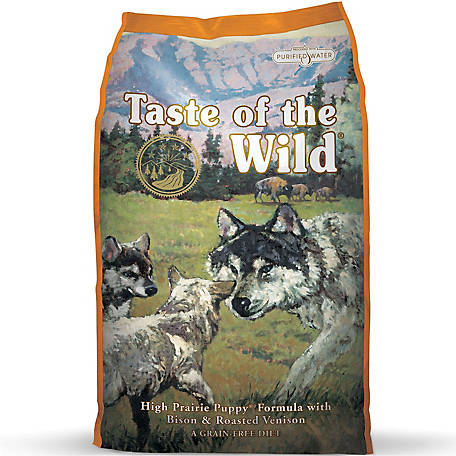Grain-Free Dog Food History
Long before dog food was scooped from a bag into personalized doggie dishes, canines would hunt and capture raw, protein-rich meals. After all, you don’t see wolves grazing peacefully in a field of flowers. Just like the theory behind the Paleo Diet for humans, protein-based, grain-free dog foods more closely mimics a canine’s natural or “ancestral” diet as a carnivore. However, with the introduction of mass-produced dog kibble around World War II, inexpensive fillers like corn, wheat and barley were added to dog food to create bulk and keep costs down. Today, most commercial dog foods still list corn or wheat as one of the main ingredients.
But while dogs have evolved from wild animals to Internet celebrities, the canine digestive system is still pretty primitive. Dogs have little natural digestive support for breaking down and metabolizing complex carbohydrates and cereal grains. These difficult-to-digest fibers and grains remain undigested, with the body relying mainly on fermentation to break them down. Over a long period of time, this can damage the lining of the digestive system, resulting in bowel inflammation disorders, food sensitivities, food allergies, leaky gut and obesity.
Does My Dog Have a Food Allergy?
If your pup is presenting these symptoms, talk to your vet. A food allergy could be to blame:
- Excessive flatulence
- Loose stool/diarrhea
- Rash and skin irritations
- Chronic licking, chewing or biting to relieve itch
- Vomiting
- Frequent ear infections
Breeds at Higher Risk for Food Allergies
Some studies also show that the following dog breeds may have a larger chance of developing food allergies:
- Retriever
- Boxer
- Chinese Shar-Pei
- Cocker Spaniel
- Collie,
- Dachshund
- Dalmatian
- Lhasa Apso
- Miniature Schnauzer
- Soft Coated Wheaton Terrier
- Springer Spaniel
- West Highland White Terrier
What Are the Benefits of Grain-Free Dog Food?
Most vets today recommend that carbohydrates and grains make up a small portion of a dog’s diet (according to Dogster: 50% vegetables/40% meat protein/10% grains). Many grain-free dog foods (especially the moist and freeze-dried grain-free dog foods) contain more protein and animal fats and fewer carbohydrates than their grain-based counterparts and are therefore more easily digested.
Other benefits include:
- Helps keep dogs fuller longer resulting in eating less frequently (good news because grain-free/high-protein foods can be more expensive)
- May reduce canine food allergies
- More energy
- Fewer and smaller stools
- Healthier skin
- Shinier coat
- Less shedding
- Better breath
- Reduced flatulence
Is Grain-Free Food Right for My Dog?
If your dog is perfectly happy and healthy, then you may not need to make any dietary changes. A good rule of “paw”: always consult your vet before making any major changes to your pet’s diet.
In the meantime, check out the ingredients label on your dog’s food or the brand’s website. If they list corn, wheat or soy as the first ingredients, you may consider gradually switching to a formula the features protein (usually chicken) as one of the main ingredients.
Tips for Going Grain-Free
If you decide to switch your dog from grain-based dog food to grain-free, don’t go cold turkey. Slowly introduce grain-free and higher protein dog food by mixing it in a little at a time. By gradually increasing amounts over the course of a few weeks, you allow your dog’s digestive system to adjust. During the switch, keep an eye on your pup’s stool to make sure they’re not constipated or suffering from diarrhea.
If you see any major concerns during the switch (hair loss, itching, lack of interest in eating or drinking water, etc.), contact your vet for next steps.
Excerpt from CanineJournal.com.

